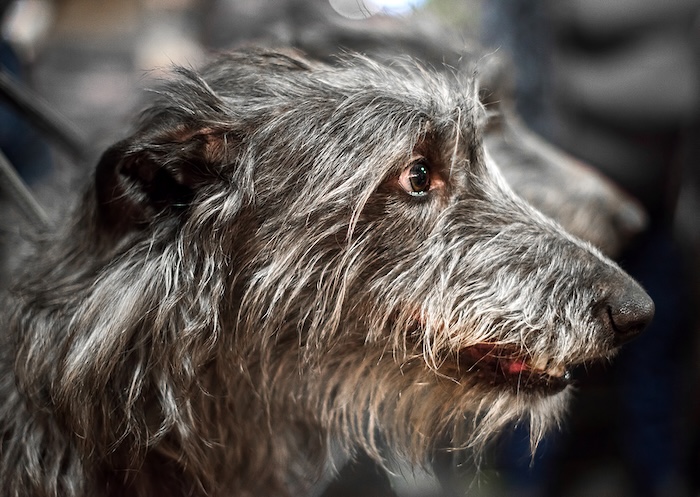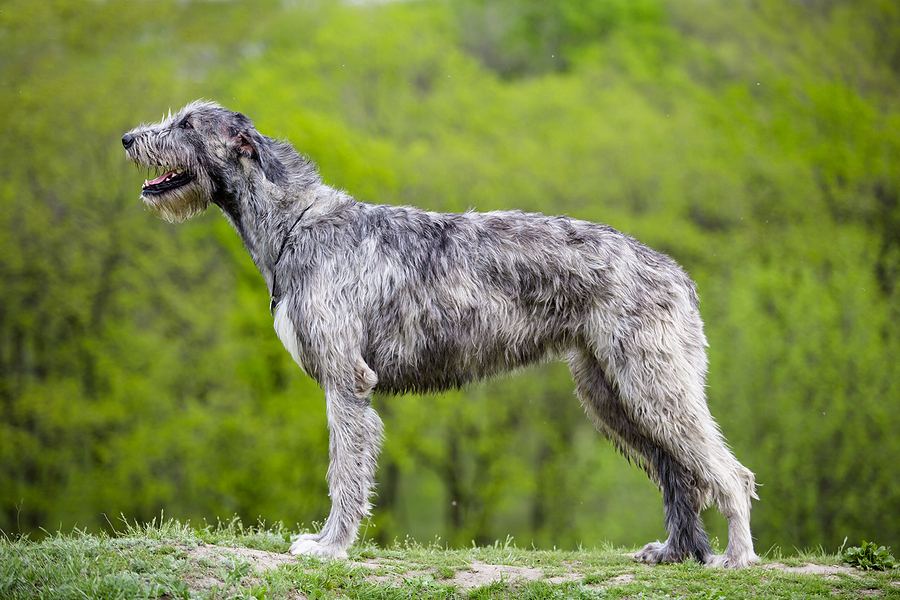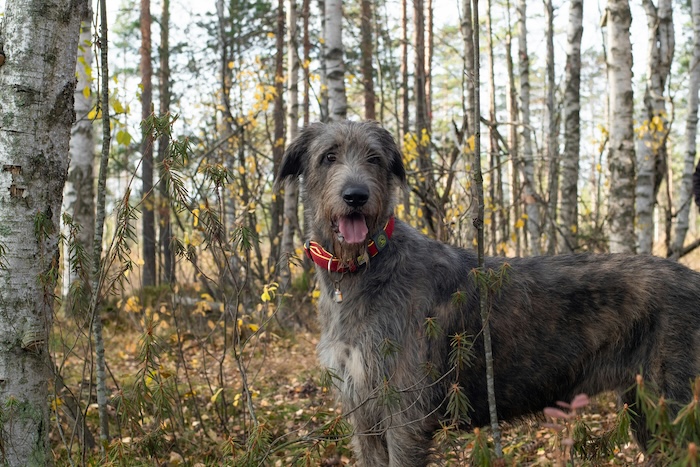This article compares the Scottish Deerhound and Irish Wolfhound, two breeds renowned for their size and speed. It delves into their histories, physical attributes, temperaments, and roles in modern society. By examining their origins, we explore how each breed has been shaped by their respective environments and purposes. The analysis highlights the subtle yet significant differences between these gentle giants, offering insights for potential owners and dog enthusiasts on what to expect from each breed in terms of care, training, and companionship.
Historical Background and Origins
Scottish Deerhound
The Scottish Deerhound, known for its grace and nobility, is a breed with a rich history that dates back to a time when the dog was the hunting companion of Scottish clans. Originating in the Scottish Highlands, the Deerhound was bred to hunt red deer and was highly valued for its speed, agility, and hunting prowess. The breed’s ancestry is believed to be ancient, with some accounts tracing its roots back to dogs that were present in Scotland before the arrival of the Scots from Ireland. The Deerhound was once known as the “Royal Dog of Scotland,” and its ownership was once restricted to those of noble birth.

Irish Wolfhound
The Irish Wolfhound boasts an equally storied past, with its origins steeped in the lore and legend of Ireland. Bred to hunt wolves and Irish elk, this breed is one of the tallest canine breeds in the world. Its history can be traced back to antiquity, with references to the dogs in Roman records as early as 391 AD. The Irish Wolfhound was highly regarded for its bravery, size, and strength, which were necessary traits for taking down large and dangerous prey. The breed nearly faced extinction in the 19th century when wolves and elk were hunted to extinction in Ireland, but it was revived by dedicated breeders.

General Characteristics and Appearance
Scottish Deerhound
The Scottish Deerhound is a large breed, though not as tall as the Irish Wolfhound, with males typically standing 30 to 32 inches at the shoulder. They possess a wiry and rough coat that comes in various shades of gray, brindle, and blue-gray. The breed is characterized by its deep chest, long tail, and elegant, yet powerful build. The Deerhound’s bearing is one of quiet dignity and gentle demeanor. Their eyes are generally dark, with a soft and friendly expression.
Irish Wolfhound
The Irish Wolfhound is known for its imposing stature, with males often standing at least 32 inches tall at the shoulder and sometimes reaching up to 35 inches or more. They have a rough coat that can be gray, brindle, red, black, white, or fawn. The breed is muscular and strong, with a commanding presence and a noble profile. Despite their size, they are known for their gentle temperament and are often referred to as “gentle giants.” Their eyes exude a calm and intelligent gaze, and they have a long, slightly curved tail.
Speed and Agility: The Scottish Deerhound
Physical Attributes Contributing to Speed
The Scottish Deerhound is a breed known for its impressive speed, which can be largely attributed to its physical build. This breed possesses a lean and muscular body, with a deep chest that provides ample lung capacity for endurance. Their long legs are not just for height; they are built for speed, with powerful muscles that propel the dog forward with great strides. The Deerhound’s light and springy gait allows for rapid acceleration and the ability to turn quickly, which is essential when chasing fast-moving prey.
The breed’s bone structure is also a contributing factor to its agility. The Deerhound has a flexible spine and well-angled hocks, which work together to provide a powerful and efficient running mechanism. Their feet are compact and well-knuckled, with strong nails that give them a good grip on the ground, enhancing their ability to maneuver at high speeds.
Hunting History and Performance
The Scottish Deerhound’s speed and agility have been honed through centuries of selective breeding for hunting. Originally bred to hunt the red deer in the rough and hilly terrain of Scotland, the Deerhound needed to be fast enough to catch up with the deer and agile enough to navigate the challenging landscape. Their hunting style involves a combination of stalking and coursing, where they quietly approach the prey and then give chase at high speed.
In the past, the performance of a Deerhound in the hunt was a matter of life and death, both for the dog and for the people relying on the hunt for sustenance. The breed’s ability to reach high speeds quickly and maintain them over long distances made them invaluable to hunters. Their agility allowed them to avoid obstacles and change direction swiftly when pursuing agile deer.
Modern-Day Activities and Competitions
In modern times, while the Scottish Deerhound may not be used as widely for hunting, their speed and agility are still celebrated and tested through various dog sports and activities. Lure coursing is one such activity that mimics the traditional hunting scenario, allowing Deerhounds to chase a mechanically operated lure over a course that requires them to sprint, change direction, and show off their agility.
Deerhounds also participate in dog shows, where their gait and build are judged. However, it is in performance events like lure coursing and open field coursing where their speed and agility are truly put to the test. These events allow the Scottish Deerhound to exhibit their natural coursing instincts and demonstrate the physical attributes that have been carefully cultivated over generations.
In addition to formal competitions, many Deerhound owners engage in activities like agility training and racing, which provide an outlet for the breed’s high energy levels and need for physical exercise. These activities not only keep the dogs fit but also serve to strengthen the bond between dog and owner through shared experience and training.
Strength and Stature: The Irish Wolfhound
Size Comparison and Physical Strength
The Irish Wolfhound is renowned for its impressive size and strength, often regarded as one of the tallest dog breeds in the world. Males typically stand at a minimum of 32 inches at the shoulder, with females not far behind. It’s not uncommon for a male Irish Wolfhound to weigh upwards of 140 pounds, with a robust and muscular build that reflects their power. Their large, strong bones and well-developed musculature are a testament to the breed’s historical purpose as a hunter capable of tackling large game. The physical strength of an Irish Wolfhound is evident in its broad chest, long and strong neck, and powerful legs, all contributing to its ability to run at great speeds and with considerable endurance.
Historical Role and Breed Development
The Irish Wolfhound’s history is steeped in the lore of ancient Ireland, where they were bred for their hunting prowess, particularly in pursuing wolves and giant Irish elk. Their size and strength made them ideal for this role, and they were highly valued by nobility. The breed’s development was focused on enhancing these attributes, with an emphasis on courage, tenacity, and power. By the 15th century, the Irish Wolfhound was well-established as a symbol of status and a guardian of homes and livestock. However, with the decline of their traditional prey, the breed’s numbers dwindled, leading to a concerted effort in the 19th century to revive and stabilize the breed through careful breeding practices.
Contemporary Uses and Breed Presence
In modern times, the Irish Wolfhound has transitioned from a fierce hunter to a gentle giant, often sought after for its calm and friendly demeanor. While they are no longer used for hunting wolves, their strength and stature have found new outlets. The breed excels in canine sports such as lure coursing, where they can showcase their speed and agility. They are also popular participants in dog shows, where their majestic appearance and noble bearing are highly prized. Despite their size, Irish Wolfhounds are known to be good companions and family pets, often described as being good-natured with children and other dogs. Their presence in the contemporary dog community is marked by a dedicated following of enthusiasts who admire the breed for both its historical significance and its amiable nature.

Temperament, Health, and Lifespan
Personality Traits and Behavior
Scottish Deerhound
The Scottish Deerhound is known for its gentle and friendly demeanor. They are often described as dignified, courteous, and extremely loyal to their families. Despite their large size, they are calm and well-mannered indoors. They have a strong prey drive, given their history as deer-hunting dogs, which can manifest in a tendency to chase after small animals. Socialization from a young age is important to ensure they are well-adjusted and sociable with other dogs and people.
Irish Wolfhound
The Irish Wolfhound is similarly known for its gentle nature. They are affectionate, patient, and great with children, making them excellent family pets. Their calm temperament makes them friendly towards strangers, though they can be reserved at times. Like the Deerhound, they have a hunting heritage, so they may also exhibit a strong chase instinct. Early socialization and training are key to managing their size and strength in social situations.
Health Issues and Breed-Specific Concerns
Scottish Deerhound
Scottish Deerhounds are generally healthy, but they can be prone to certain genetic health issues. These include cardiomyopathy (a heart condition), bone cancer (osteosarcoma), and gastric torsion (bloat). Regular health screenings and veterinary check-ups can help in early detection and management of these conditions. Owners should be aware of the signs of bloat, a life-threatening emergency that requires immediate veterinary attention.
Irish Wolfhound
Irish Wolfhounds share some health concerns with the Scottish Deerhound, including cardiomyopathy and bloat. They are also susceptible to bone cancer and joint issues such as hip dysplasia due to their large size. Regular health checks are crucial for early detection of these conditions. Maintaining a healthy weight and providing appropriate exercise can help manage and prevent joint problems.
Lifespan and Care Requirements
Scottish Deerhound
The lifespan of a Scottish Deerhound is typically around 8 to 11 years. They require regular exercise to maintain their health and prevent obesity. Their coat needs routine grooming to keep it in good condition, and they shed moderately. Due to their size, they do best in a home with ample space to move around.
Irish Wolfhound
Irish Wolfhounds have a similar lifespan to the Scottish Deerhound, often living between 6 to 10 years. They need daily exercise to stay fit, but it should be moderate to avoid putting too much strain on their joints. Their rough coat requires regular brushing to prevent matting. They are not heavy shedders but do require more space due to their even larger size. Both breeds benefit from a well-balanced diet formulated for large breeds with specific attention to their growth and development stages.
